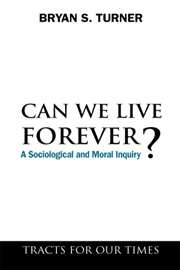Book contents
- Frontmatter
- Contents
- Acknowledgements
- Can We Live Forever?
- Chapter One Longevity and the Population Debate
- Chapter Two The Social Utopia of Human Perfection
- Chapter Three Ancient and Modern Techniques of Longevity
- Chapter Four The Political Economy of Ageing
- Chapter Five The Moral and Spiritual Character of Old Age
- Chapter Six Vulnerability and the Ethic of Care
- Chapter Seven Towards a New Paradigm of Ageing
- Chapter Eight The Aesthetics of Ageing
- Bibliography
- Index
Chapter Eight - The Aesthetics of Ageing
Published online by Cambridge University Press: 05 March 2012
- Frontmatter
- Contents
- Acknowledgements
- Can We Live Forever?
- Chapter One Longevity and the Population Debate
- Chapter Two The Social Utopia of Human Perfection
- Chapter Three Ancient and Modern Techniques of Longevity
- Chapter Four The Political Economy of Ageing
- Chapter Five The Moral and Spiritual Character of Old Age
- Chapter Six Vulnerability and the Ethic of Care
- Chapter Seven Towards a New Paradigm of Ageing
- Chapter Eight The Aesthetics of Ageing
- Bibliography
- Index
Summary
An aged man is but a paltry thing,
A tattered coat upon a stick, unless
Soul clap its hands and sing, and louder sing
For every tatter in its mortal dress.
— W.B.Yeats, ‘Sailing to Byzantium’ from The TowerIntroduction: Types of Survival
We can now see that the controversial but simple question – can we live forever? – has a variety of answers. In retrospect, we can now distinguish three basic forms of survival (Callahan, 2009). The first is basically the status quo, which is a relatively long life in historical terms, but with all the disability and immobility that normally goes with ageing. This scenario is obviously undesirable for the individual and costly for society in terms of rising healthcare bills. The second type would be an extension of life with little disability and a quick death. In this form, medicine has successfully addressed most of the diseases of ageing without offering us immortality. From an individual perspective, this outcome is clearly desirable. Finally, we could contemplate decelerated ageing which would simply mean slowing down the ageing process, and then there might be arrested ageing in which ageing could be delayed or deferred for an indefinite period. The aim of the Immortalists is some version of arrested ageing in which morbidity could largely be eliminated and immortality could be delivered through extensive geriatric engineering. This outcome is clearly problematic from a social and economic point of view, and it may be deeply disturbing for the individual, given the problems of boredom and despair that I have tried to describe earlier.
- Type
- Chapter
- Information
- Can We Live Forever?A Sociological and Moral Inquiry, pp. 139 - 146Publisher: Anthem PressPrint publication year: 2009



